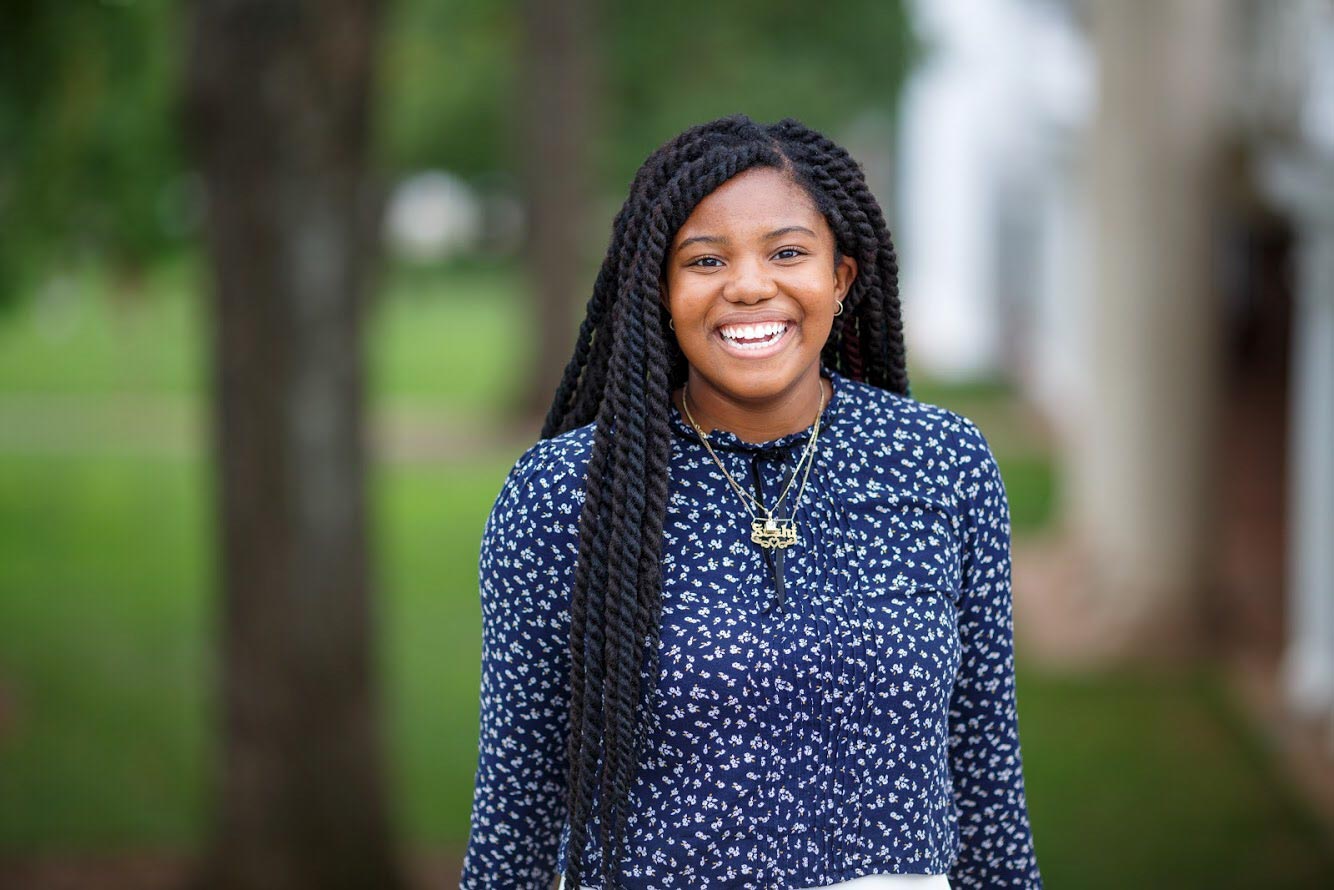Find the latest information on the University’s response to the coronavirus here.
Seshi Konu remembers going to Campbell Hall, home of the University of Virginia’s School of Architecture, early before her class began just so she could walk around the studio and look at the work on students’ desks and on the walls, and at the projects in progress.

“I was intrigued,” Konu said in an email, writing from Norfolk where she was born and raised. “It was my first time in Campbell Hall – and I haven’t left since.”
Although she has been finishing the semester at home for the last seven weeks since the coronavirus pandemic hit, she talked about school in the present tense.
In her first year as a UVA student enrolled in the College of Arts & Sciences, Konu said she “was exposed to a range of courses and people who were all pursuing all kinds of studies.”
But that did not include the School of Architecture – at least at first.
A volunteer pursuit, however, took her in a different direction than where she expected, one that led her to an innovative approach in architecture that is gaining momentum: design thinking.
Learning about architecture and design thinking led her to realize she has the power to participate in shaping a better world, one she would like to see – that emphasizes equity and inclusion.
When Konu started volunteering in her second semester with VISAS – Volunteers with International Students, Staff, and Scholars – she happened to be matched with a group of international graduate students in the Architecture School. The students practiced speaking English by presenting their projects and showing their work to her.
“Believe it or not, this was my first real introduction to architecture, other than being a hardcore fan of [interior designers] Candice Olson and Vern Yip [a UVA alumnus] from watching HGTV with my mom,” Konu said.
Her mother and her family are from the Norfolk area and her father is from Accra, Ghana. Growing up, she remembers their home filled with relics, textiles and artifacts of family culture – from kente and other West African cloth to wooden sculptures.
“Architecture as a discipline had never been on my radar. It was still something that I could never really see myself pursuing as a career,” Konu admitted, so transferring into the Architecture School “was a really big shift for me, but I embraced it with open arms and I’m glad I did.”
“Seeing that plenty of students were making thoughtful creations and designs of their own really inspired me. Something just clicked.”
Another college pursuit also encouraged her decision toward architecture: she received a 2½-year fellowship from UVA’s Meriwether Lewis Institute for Citizen Leadership, which requires the 25 students of each cohort to take assistant professor of architecture Elgin Cleckley’s “Foundations of Design Thinking” course. Meriwether Lewis fellows then work on summer projects based on real-world issues using design-thinking principles.
“Design permeates every aspect of our lives,” Konu said, “and holds great power in determining behaviors, emotions and other personal and community trajectories. In many ways, space is a conduit through which we receive messages about who is important and who is not. Structural racism and classicism pervade our systems, and our geographic landscapes are no exception. I am interested in identifying these markers, both covert and overt ones, and working to establish new typologies of public space, housing and infrastructure that reconcile them.
“There are so many forces working around us, and we don’t even realize it most of the time,” Konu said.
It fascinated her to realize she could look at things like the urban landscape of Barcelona, where she spent last fall semester, or the UVA bus routes or the area where Interstate 95 cuts through Richmond and redesign spaces like these to be more beneficial to the people closest to them.
From associate professor Mona El Khafif, who became her thesis adviser, Konu said she learned about “urban scenography” – “to reimagine public space, think about it more theatrically to make the space [come] alive and interactive in new ways.”
El Khafif said she knew a thesis project like Konu’s – about redesigning a devastated neighborhood in Richmond that I-95 passes over – would be novel and experimental.
“She is a very hard-working student, but you can also see that she truly enjoys to design her project,” El Khafif wrote in email. “She listens carefully and picks up on ideas that we are discussing, but every time when I saw her again in studio I knew that she would bring something new to the table – something that she discovered while working on her project.”
In addition to thinking of the highway redevelopment project in terms of choreography, Konu also has taken into account the history of the area. The construction of Interstate 95, which became one of the busiest highways in the country, ripped a block out of the Jackson Ward neighborhood in Richmond; likely traversed an African burial ground; and ignored the site of the second-largest slave market in the U.S. It’s now largely paved for parking lots or open abandoned space.
Konu is suggesting making it a space of restitution, this small space dealing with all of that history. Any plans for the highway should give the community time to think of the space, located under the elevated highway, as a work in progress, Konu said. At this early stage, she’d have a series of scaffold structures erected for flexible space that could take on different events that could be related to moments in history or other narratives.
This is an American problem, she pointed out, because the interstate highway system is federal. In this project, she tackles it locally and considers solutions for highways at large.
As she finishes her UVA experience from afar and moves on, Konu said her plans for what comes next are still up in the air, but she remains optimistic. She might spend the summer volunteering as she looks for work, possibly using her skills from working as a UVA Career Peer Educator to tutor, counsel and advise younger students.
Konu worked at the UVA Career Center in this role for two years, helping other undergraduates with résumés, cover letters, and connecting them to helpful resources on or off Grounds, especially with the science and sustainability career community.
“I was inspired to join the team because my own journey has been nonlinear and although I am glad I’m here now; it was not easy. Hands down, the best part of the job is when I can sense a wave of comfort come over my peers, or I can make them laugh, or connect them to an opportunity at UVA.”
Although she had already been doing a lot of schoolwork online, “It has certainly been an adjustment reducing the majority of my life and social interactions to my 15-inch laptop screen,” Konu said.
“It’s this focus, however, that has encouraged me to slow down and connect with those I value and appreciate,” she said. “It has been really nice to reconnect with family near and far and to watch as people come together to encourage and support one another.
“Like many of us, I have turned to the kitchen as a major source of exploration and experimentation to get away from the screens. I have really enjoyed perfecting my marinades and dry rubs.”
Konu said her biggest takeaway from her UVA education has been “to take ownership” of her education.
“Student self-governance for me has really been a lesson in actively shaping the world that we want to see – and I almost mean that literally, as I want to work in architecture and design. Before UVA, I’m not sure I realized my power, but today I walk away with the core beliefs of lifting others as I climb, as a black woman especially, and using my work to promote equity.”
Media Contact
Article Information
May 1, 2020
/content/class-2020-seshi-konu-found-surprise-design

